Top 10 Email Campaigns Every eCommerce Business Should Automate

Table of Contents
With email marketing, you reach out to existing and potential customers and drive
sales. Automation takes it a step further, working like a 24/7 support team that sends timely, personalized
messages based on customer behaviour.
From welcoming new subscribers the moment they sign up to recovering abandoned
carts or confirming orders, automated emails keep your marketing running smoothly without manual effort.
That said, effective automation starts with a clean email list. By regularly
removing inactive subscribers and invalid addresses, you ensure your emails land in inboxes and maintain high
deliverability. This way, every automated message counts.
In this post, we’ll walk through the top 10 email campaigns every eCommerce
business should automate. These essential campaigns not only boost engagement and conversions but also help
build long-term customer loyalty.
What Is Email Marketing Automation?
Email marketing automation is one of the
core functionalities of every great email platform and plays a key role in your strategy.
In simple terms, an automation is a workflow that starts with a trigger,
continues by evaluating a set of conditions, and ends with an action.
In eCommerce email marketing, the trigger is a customer's interaction—a subscription, for example, or a purchase—and the action is the email campaign sent:
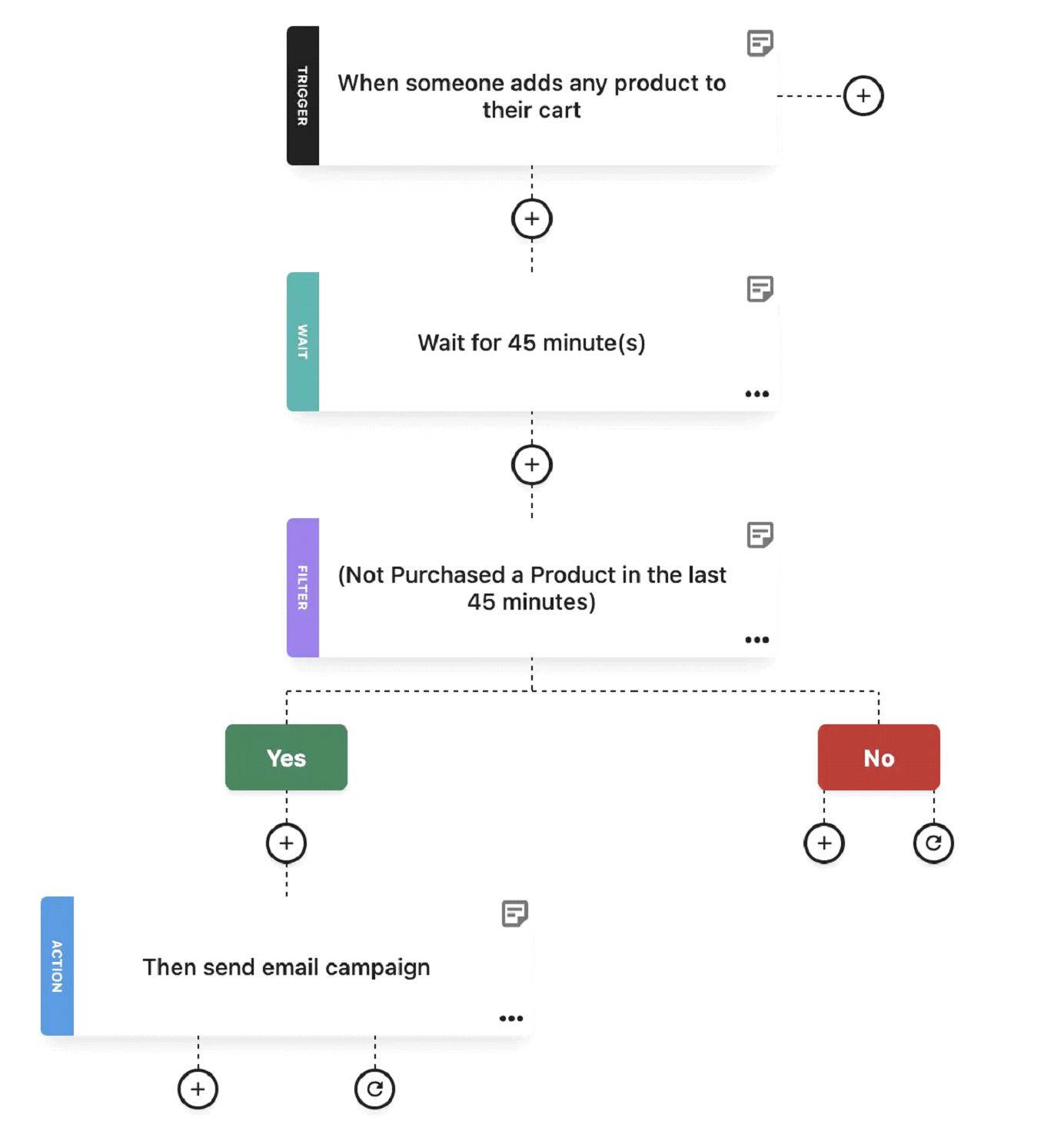
And since automated email campaigns stem from a real user action, they're far more
likely to feel personal and prompt recipients to act.
To build such sequences, you need email tools with
powerful automation features. Some of them like Moosend and ActiveCampaign are among the most feature-packed and
affordable email marketing automation platforms, helping you level up your eCommerce email marketing without breaking the bank.
The 10 Email Campaigns Your eCommerce Brand Should Automate
Each brand has its own audience and marketing plan, of course. But there are some eCommerce email campaigns every brand should incorporate into their email marketing strategy.
Let's see which ones they are.
1. Welcome Email Campaigns
The moment a prospect signs up to your list is a golden opportunity. New signups are interesting, curious, and open to hearing more. And first impressions matter, especially in eCommerce.
A well-crafted welcome email series is your opportunity to introduce new subscribers or first-time customers to your brand, set expectations, and start building trust from day one. It sets the tone for your relationship with your new subscribers and helps turn initial interest into a purchase:
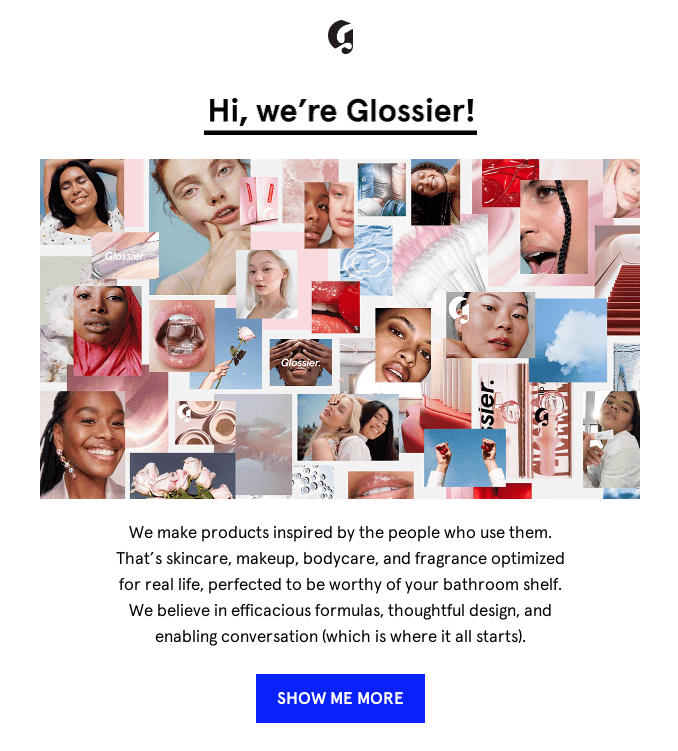
This example from Glossier feels like a
digital handshake. It welcomes new subscribers to a fun and glowing space—as evident by the visual—and explains
what the brand’s mission is. The “show me more” button is a nice CTA that gets new subscribers from point A,
which is the email, to point B, the website.
The subject line reflects both the objective and the brand
itself: “Your first email.” It’s a great introduction to a youthful brand.
But it doesn’t stop there.
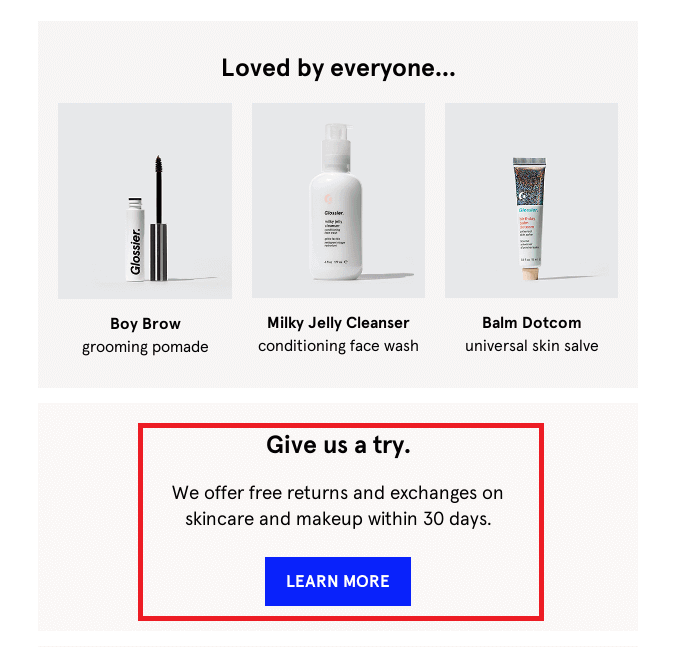
With a welcome series, the brand makes sure to let them know all about their bestsellers and their generous return policy. This is a great
way to improve the purchasing process right off the bat. Being transparent builds trust and nurtures leads.
A welcome email series doesn’t just educate audiences. It builds familiarity and drives that highly important
first conversion.
So, once you automate it, it runs quietly in the background and welcomes new subscribers
for you, while you focus on more complex things like growing your store.
2. Abandoned Cart Email Campaigns
Abandoned cart emails are sometimes what's standing between your customers and conversion. Studies show that about 70% of shopping carts are abandoned:
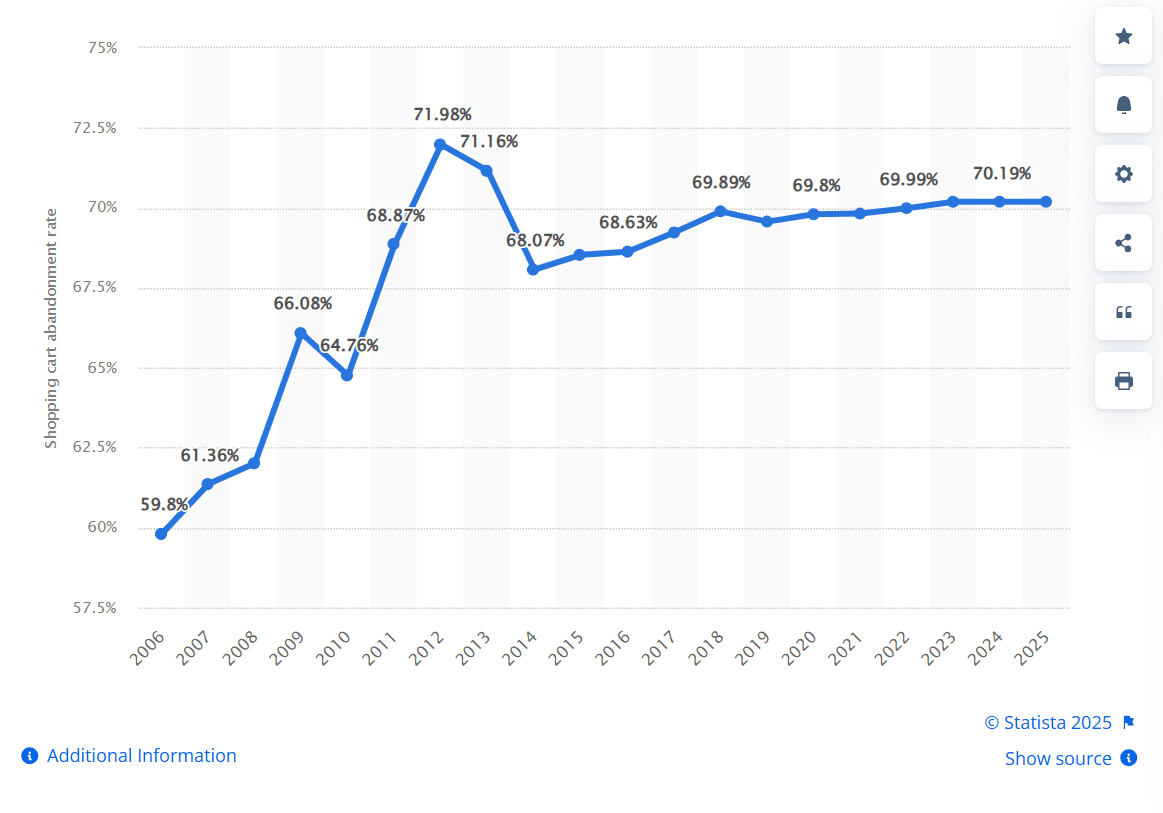
The image above is clear: If you don’t set up a cart abandonment
automation sequence, you’re probably leaving money on the table.
A well-timed abandoned cart email can
recover a good chunk of those seemingly lost sales. And since it’s triggered by a real user action, it directly
targets people who were quite literally one click away from completing the purchase.
This is what makes a
cart abandonment workflow so popular.
Of course, timing is everything when it comes to abandoned cart emails.
A good rule of thumb is to send the first reminder within an hour of abandonment, when the intent is still
high.
Follow up with a second email 12–24 hours later, and, if needed, a third after 48–72 hours. Each
message should gently nudge them back to their cart without feeling like spam.
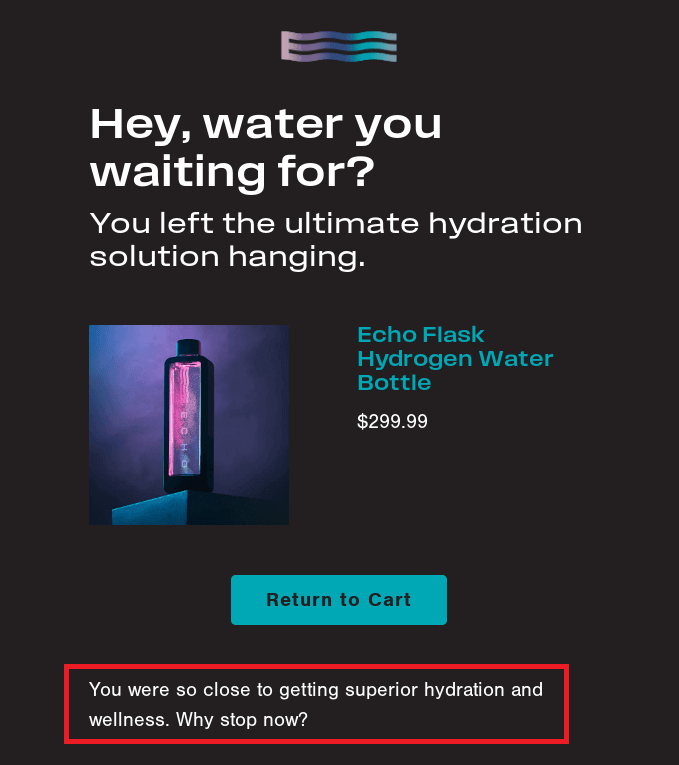
This abandoned cart email from Echo is a great
example of the above. It starts with a clever pun, and the copy under the CTA reminds users of the reason why
they wanted to proceed with the purchase in the first place—superior hydration.
The email continues with
reminders of why a customer should proceed with a purchase like this. Including social proof is a nice
touch:
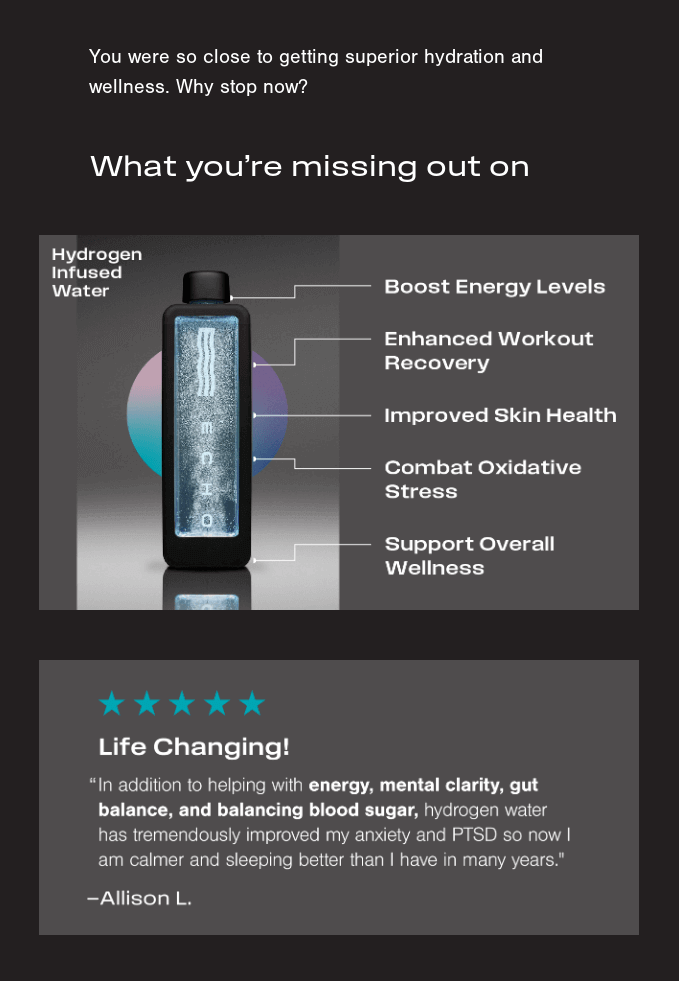
To make this email really work, Echo leaned heavily
into personalization, including the exact item left behind. The product image used has a breakdown of the item’s
components, answering a pressing question: “Why should I buy this item?”
Finally, the CTA is clear and leads
users to act.
When done right, cart abandonment emails can be very helpful and not feel pushy. If you manage
your data and use email validation tools to ensure the abandoner entered a
correct email address, you’ll reach the inbox every time and save those lost sales.
3. Thank You Email Campaigns
Right after a purchase, customers are excited—but also a little anxious, especially if it’s their
first order. That’s why your first follow-up email should go out quickly and express gratitude and reassurance.
A simple “thank you” message paired with order details and a tracking link helps confirm that everything went
smoothly and keeps customers in the loop.
The sale isn’t the end goal. It’s just the beginning of a
relationship between your brand and your customers. A thoughtful thank-you email will not only improve customer
satisfaction, but will also build trust, encourage repeat business, and help first-timers become loyal
fans.
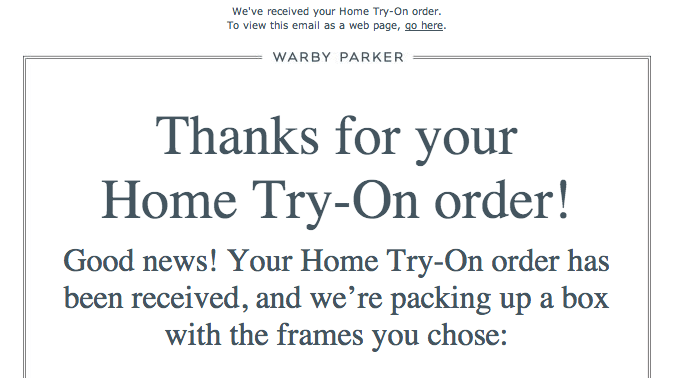
This email from Warby Parker aims to thank
customers for their order, ease any worries they might have regarding the legitimacy of the brand, and confirm
that they've ordered exactly what they wanted. But it doesn't stop there:
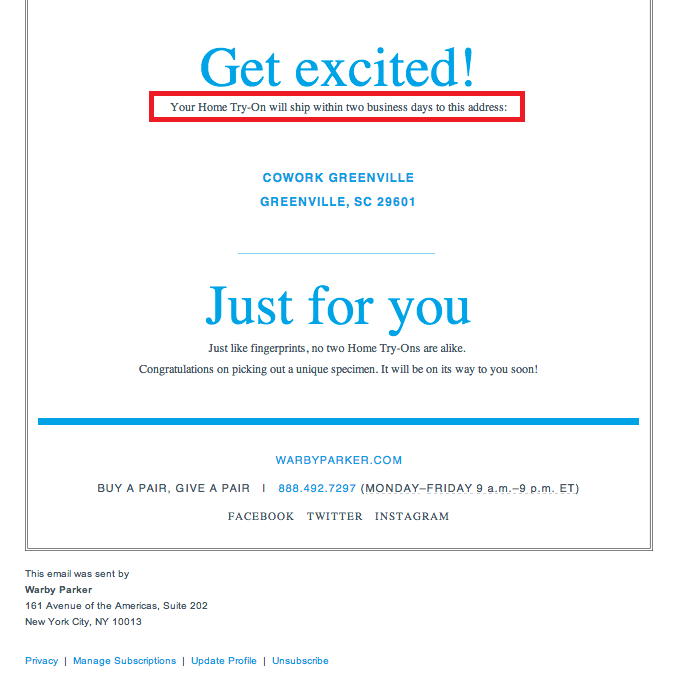
The email clearly states when the shipping process will begin, which contributes to the image of a transparent eCommerce brand. Not being transparent about your order processes is one of the most common and most loathed eCommerce marketing mistakes.
The
thank-you email stage is also perfect for inviting feedback or a product review, which builds social proof and
gives you valuable insight into the customer experience.
Automating your thank-you emails ensures every
buyer gets the same thoughtful experience without adding to your workload. When done right, these emails feel
less like marketing and more like excellent customer service.
4. Birthday or Anniversary Email Campaigns
Milestone emails are a subtle but powerful way to celebrate your customers and show them that your
relationship goes beyond transactions. When done right, these emails don’t just make someone smile. They often
lead to a purchase.
To automate this kind of campaign, you’ll need to collect the right data. A customer’s
date of birth can be gathered upon sign-up or through a quick survey. For anniversary emails, you can use the
date of their first order or the date they joined your email list. Most email marketing platforms make it easy
to set up triggers based on these milestones, seeing as personalization of that level is seen as one of the
core email marketing best practices.
Once the trigger is in
place, all that’s left is to craft the perfect gift:
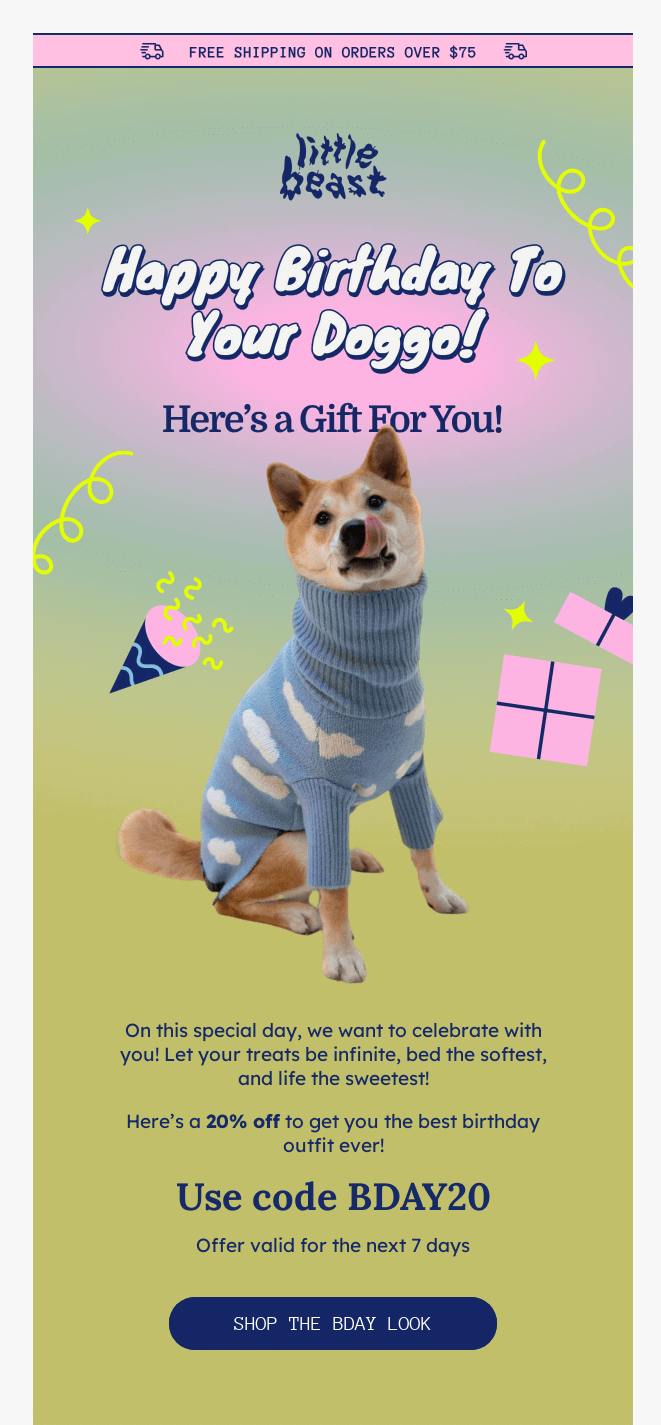
Source: Really Good Emails
This anniversary email by
Little Beast is playful and heartfelt—both elements consistent with the brand. With whimsical visuals and
casual, humorous copy, it creates a personal connection while celebrating a milestone, effectively reinforcing
customer loyalty and appreciation.
And the gift? The brand offers a promo code as part of the birthday
celebration, with clear urgency (“Offer valid for the next 7 days”).
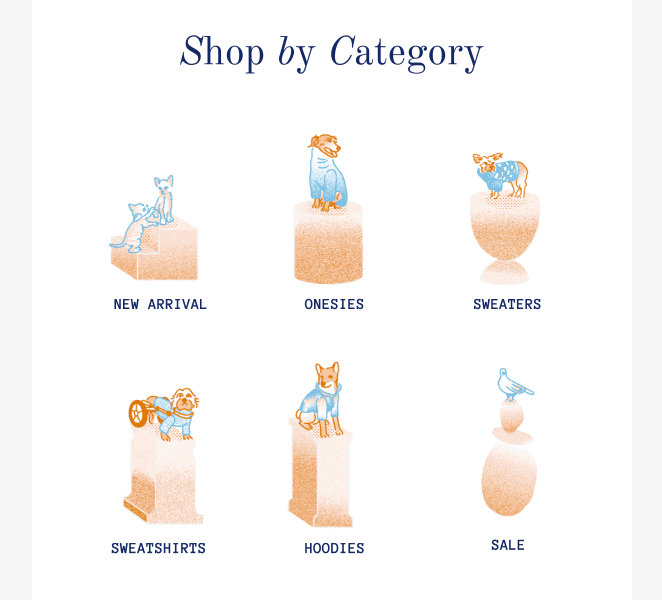
The “Shop by Category” section is visually
engaging, guiding customers toward key product types where the discount can be applied—it's a discount for a
birthday outfit, after all—like onesies, sweaters, and sale products. This makes browsing and upselling
easier.
5. Transactional Email Campaigns
Transactional emails are some of the most important and most
opened messages in your entire email marketing strategy.
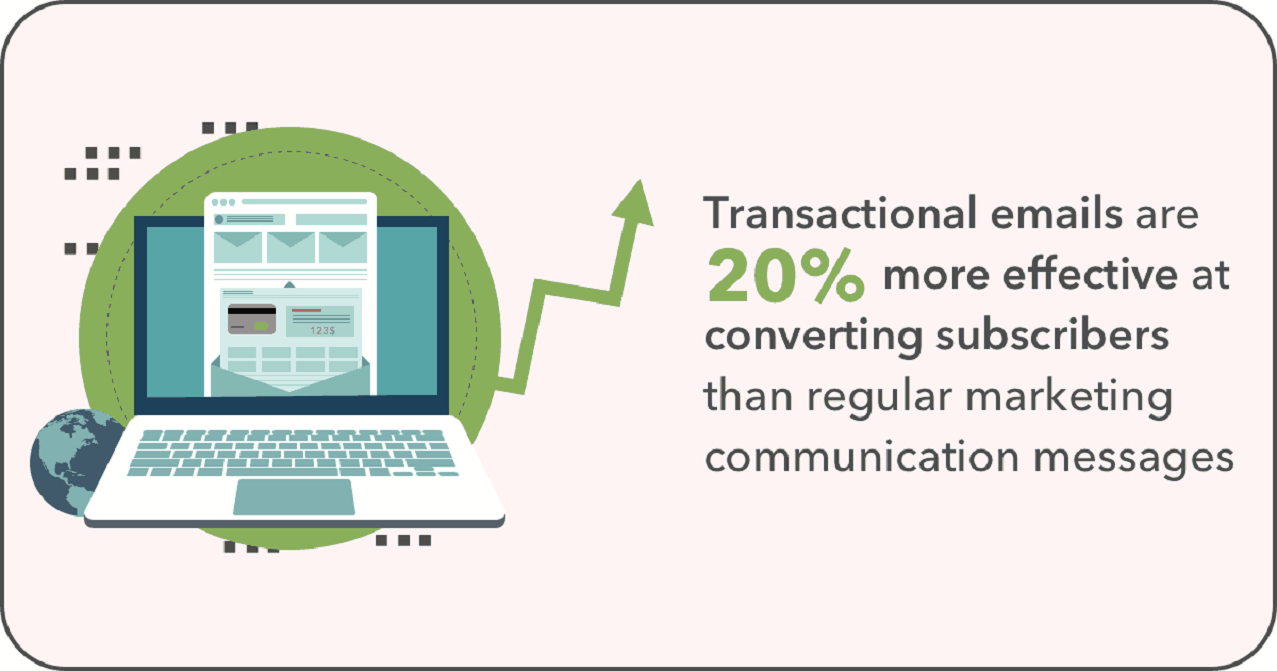
Source: Website Planet
These include order confirmations, shipping updates, password resets, and receipts. These are
emails your customers expect, trust, and engage with.
But just because they’re functional doesn’t mean they
have to be boring.
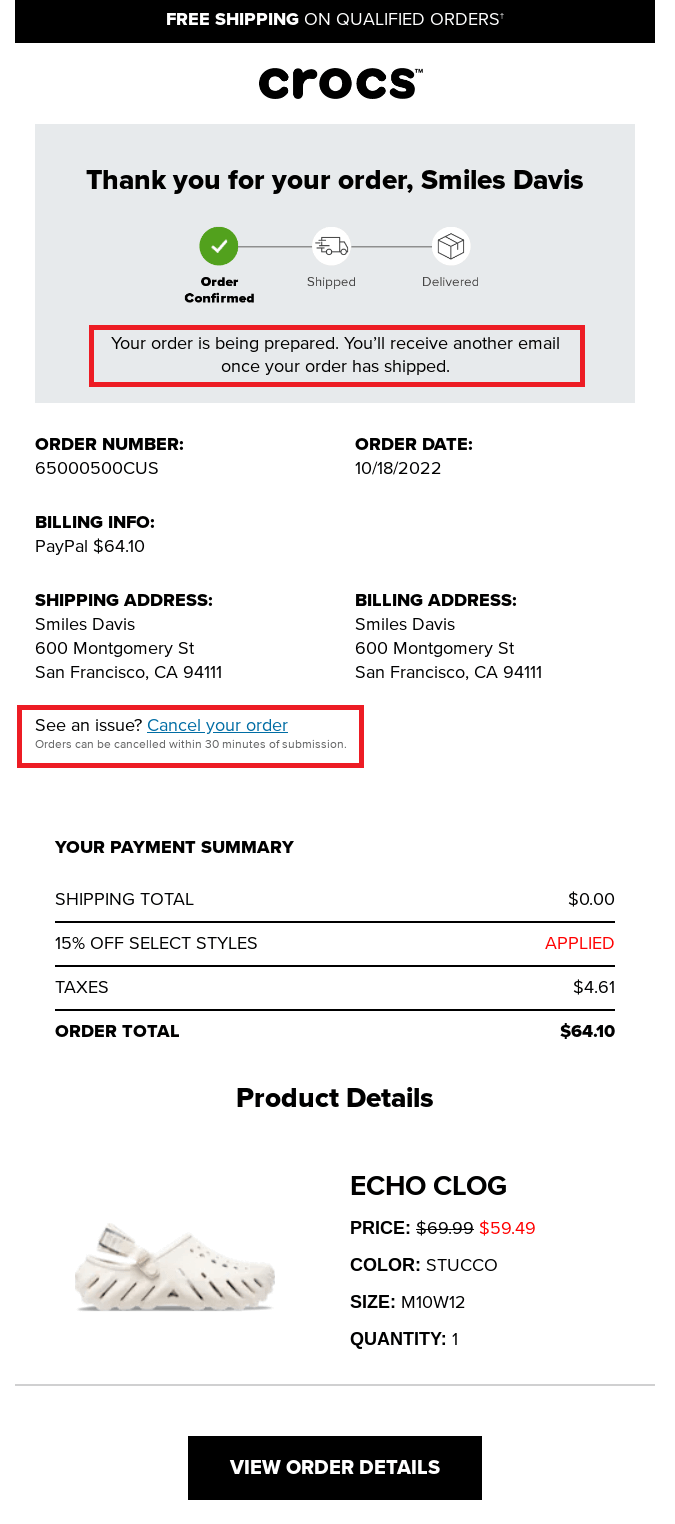
This example from Crocs makes sure all the essentials
are crystal clear: The order details at the top of the email, the billing and shipping information, and the
"Cancel your order” direct link are all there.
Now, once the basics are covered, you can thoughtfully layer
in branding, product recommendations, or even loyalty program mentions without overwhelming the
message.
A beautifully styled shipping confirmation, for instance, reinforces brand trust and offers
subtle upsell opportunities like “You might also love” or “Add this to your next order.”
When it comes to
transactional emails, timing is non-negotiable. These emails should be triggered instantly after any
transaction. A delay in sending a receipt or confirmation—or even worse, the wrong receipt or confirmation—can
make customers lose trust.
While transactional emails are not sales emails by nature, they are still
touchpoints in your customer journey. They offer a perfect moment to gently reinforce brand value, encourage
repeat engagement, and improve customer satisfaction. All while staying compliant with transactional email
regulations.
And since you're sending a triggered email that has been explicitly requested by the customer,
you're bound to avoid spam, as the customer's email can't possibly be a
spam trap.
6. Back-in-Stock Email Campaigns
Few things are more frustrating for a shopper than not
finding their favorite product in stock. It’s a small disappointment that can create a big drop-off in sales and
customer satisfaction.
That’s where back-in-stock emails shine. These automated messages let your customers
know when the item they wanted is available again, creating a sense of exclusivity and excitement. It’s a simple
way to re-engage potential buyers, recover lost revenue, and keep them as members of your online community.
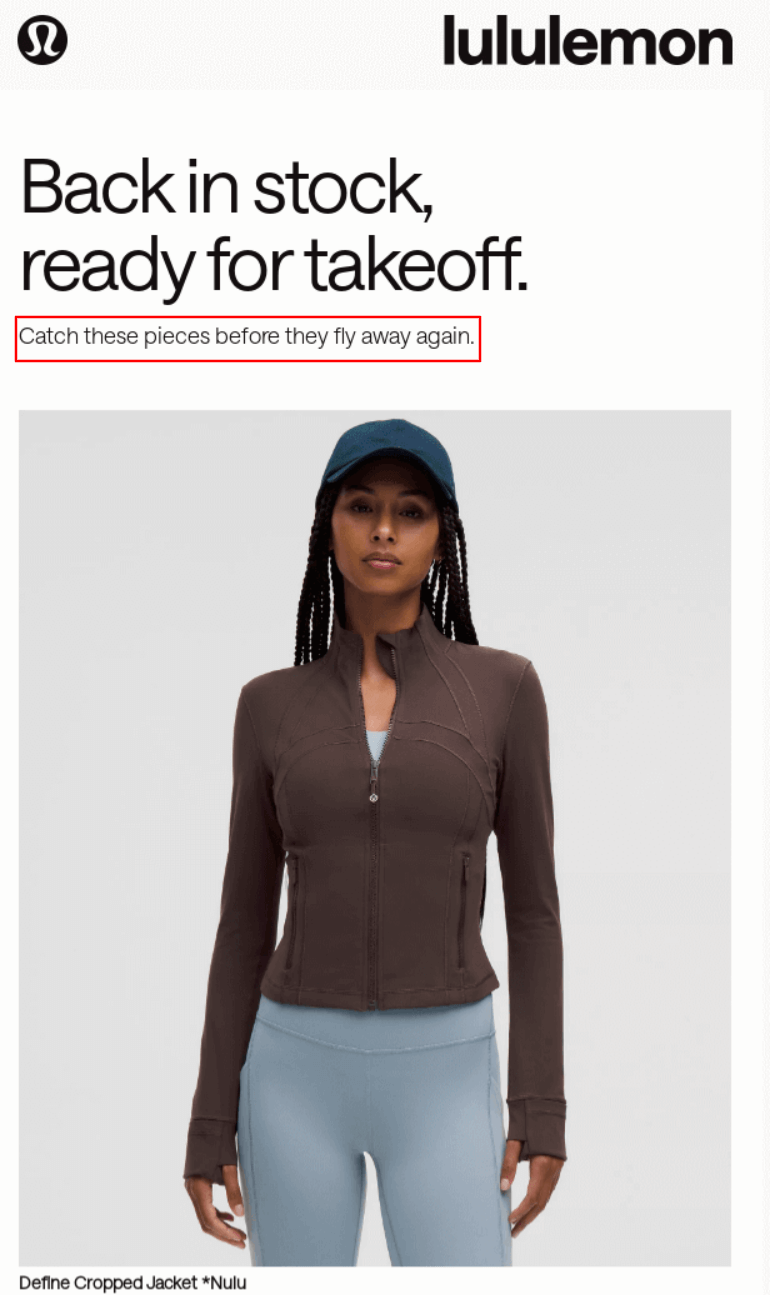
This back-in-stock email from Lululemon uses strong visual hierarchy and minimalist design to
highlight a single product. The phrase “Catch these pieces before they fly away again” adds urgency and plays
cleverly on the “takeoff” theme, encouraging immediate action while subtly suggesting limited availability. It’s
simple, effective, and persuasive.
What makes this email particularly effective is the automation behind it.
When a customer subscribes to notifications about a specific sold-out item, they’re added to a dedicated segment
of the brand’s mailing list. This automatically enrolls them in a workflow that triggers the email as soon as
the product is back in stock. Once the system detects the inventory update, it instantly sends a targeted
message to everyone who signed up, ensuring they’re the first to know.
Featuring high-quality images of the
product and using copy that builds urgency makes the email quite compelling.
If you want to go the
extra mile, offer a special incentive or product bundle. Adding a snippet of a customer review or rating can
help tip the scales too, by reinforcing demand and trust.
7. Replenishment Email Campaigns
When
you're selling consumable or regularly-used products like skincare, pet food, vitamins, or even coffee, timing
is everything. Replenishment emails are designed to catch customers right before they run out, making reordering
as seamless as possible.
These emails are particularly powerful because they’re proactive. Instead of waiting
for a customer to remember they need to restock, you reach out first, solving a problem before it even exists.
That kind of thoughtful timing not only increases repeat purchases but also promotes trust between the customer
and your eCommerce store.
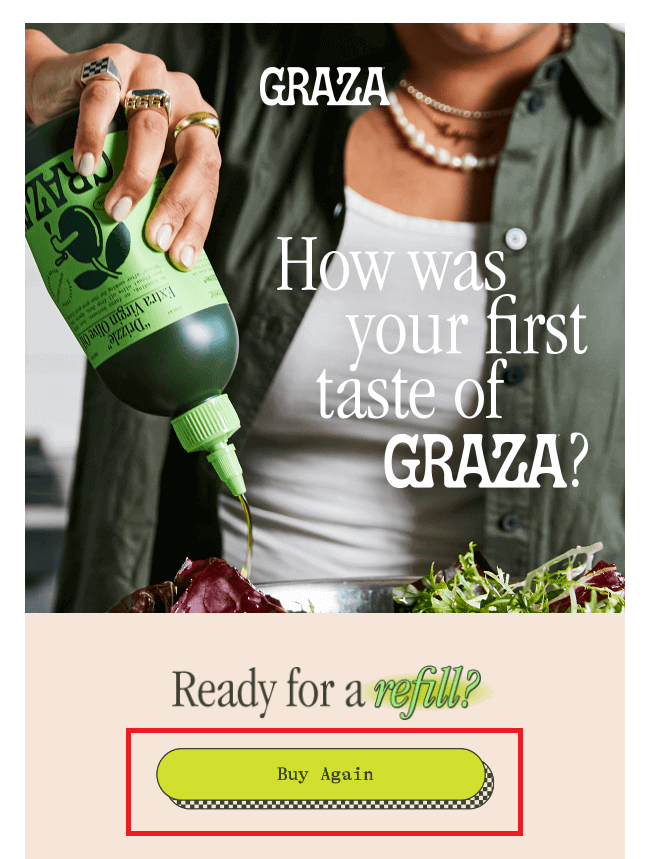
Source: Really Good Emails
This email from Graza
accomplishes a very important task: It keeps the olive oil eCommerce brand top-of-mind and relevant just as the
customer is ready to re-purchase.
To get it right, you’ll need to estimate the average time it takes for
someone to consume the product. This could be based on your own data (e.g., a 1-litre bottle of olive oil could
last about a month if the customer's diet is mainly Mediterranean) or on purchase history. Most email marketing
platforms allow you to trigger these emails automatically based on order date and product type.
The message
itself should be friendly, helpful, and low-pressure. A simple “Running low?” paired with a photo of the product
and a “Reorder Now” button often does the trick.
Think of replenishment emails like a PR tool or a
salesperson that does the heavy lifting for you. It's there to remind users of your brand right when they need
it.
8. Re-Engagement Email Campaigns
Not every customer who walks away is gone for good. That’s where
re-engagement emails—otherwise known as retention emails—come in. These emails are designed to re-engage
subscribers or customers who haven’t interacted with your brand in a while, giving you a second chance to
capture their attention and make them convert.
Start by defining what “inactive” means for your eCommerce
store, as this will be your trigger. It could be no purchases in 90 days, unopened emails for 6 months, or no
site visits over a certain period. Once you’ve identified these segments, it’s time to reach out with a message
that’s both compelling and relevant:
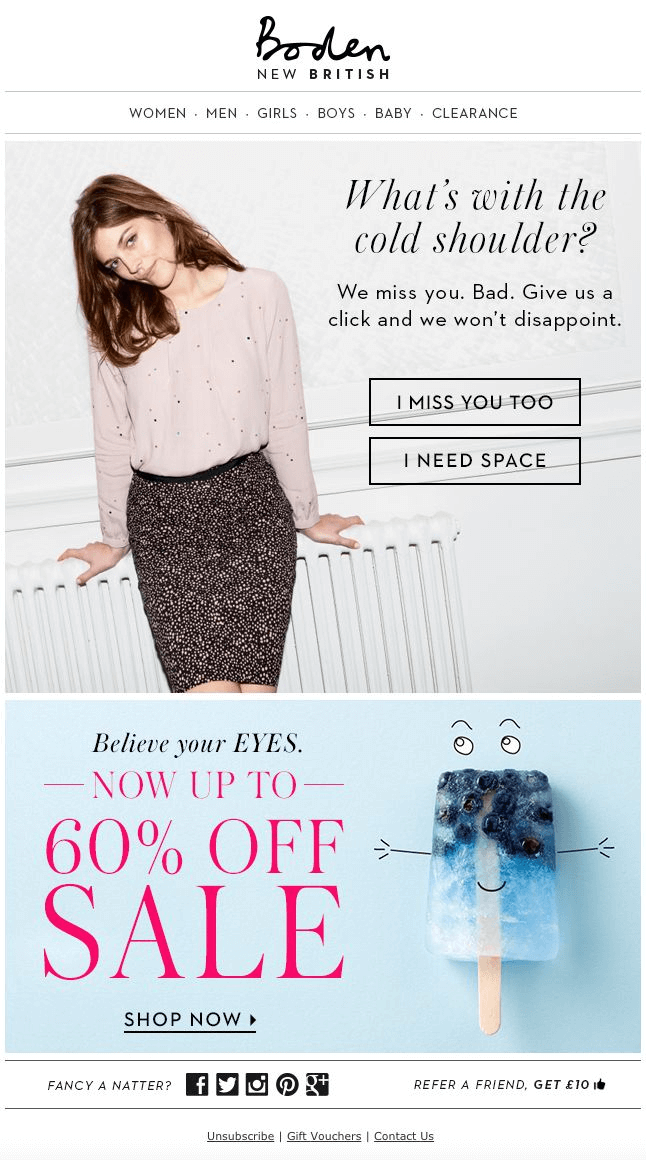
Source: Boden
This example from Boden works
beautifully, all while being fun and engaging:
✔️ It acknowledges the silence. The friendly copy that says “We miss you” and the CTAs (“I miss you too”, “I need space”) feel personal and direct.
✔️ It offers an incentive. A 60% discount in our case. It could be free shipping, or loyalty points, as they can reignite interest without being too overwhelming.
✔️ It creates urgency. The email includes the “Shop Now” CTA to encourage fast action.
Of course, when it comes to re-engagement emails, timing matters. You don’t want to overwhelm inactive users with frequent emails that can lead to spam complaints or unsubscribes. Instead, space them out thoughtfully. One well-timed email with a great offer often performs better than several aggressive nudges.
✔️ It acknowledges the silence. The friendly copy that says “We miss you” and the CTAs (“I miss you too”, “I need space”) feel personal and direct.
✔️ It offers an incentive. A 60% discount in our case. It could be free shipping, or loyalty points, as they can reignite interest without being too overwhelming.
✔️ It creates urgency. The email includes the “Shop Now” CTA to encourage fast action.
Of course, when it comes to re-engagement emails, timing matters. You don’t want to overwhelm inactive users with frequent emails that can lead to spam complaints or unsubscribes. Instead, space them out thoughtfully. One well-timed email with a great offer often performs better than several aggressive nudges.
9. Upsell and Cross-Sell Email Campaigns
From first-time purchases to loyal repeat
orders, upsell and cross-sell emails are some of the most powerful revenue drivers in an eCommerce email
strategy, as they help both brands and customers. Brands give their bottom line a quick boost, while customers
discover complementary products that enhance their original purchase—sometimes at a discounted price that can
help them save money.
Automate your upsell and cross-sell campaigns around key moments like
post-purchase confirmations or product delivery dates. Or even go for niche triggers relevant to your audience,
like offering matching accessories for a specific product line or upgrades for popular items. This ensures you
never miss a sales opportunity and can focus your energy on optimizing performance.
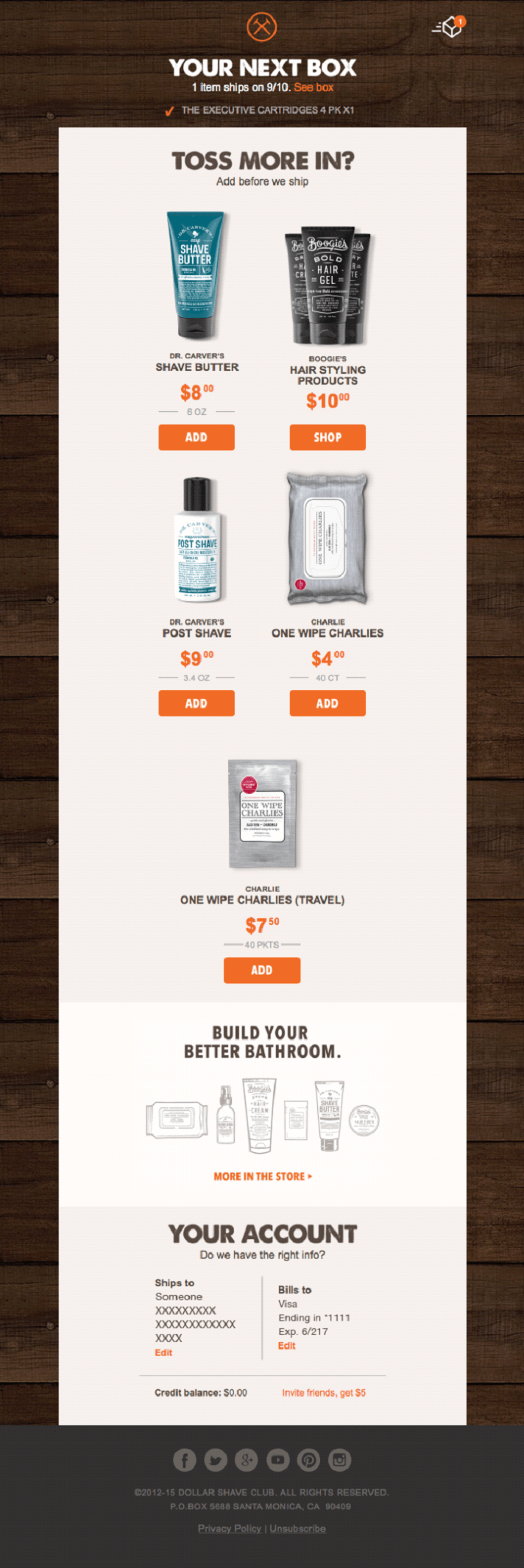
This email from Dollar Shave Club
encapsulates the “upsell and cross-sell” meaning perfectly, with the “Toss more in?” But would that email be
relevant to every buyer segment?
The answer would be no. This is why your upsell and cross-sell email
campaigns should start with segmentation and personalization.
Segment your list based on past purchase
behavior. Shoppers who bought high-end items, for example, may appreciate premium add-ons, while budget shoppers
might prefer affordable accessories. Tailoring your message to their interests gives your emails a much better
chance of being opened, clicked, and acted on.
Don’t forget to build urgency. Upsell and cross-sell emails
thrive on time-sensitive language like “Limited stock,” “Only a few left,” or “Special offer ends soon.”
Countdown timers and bold CTAs can boost clicks and drive fast decisions.
Automating your upsell and
cross-sell email campaigns will keep you top-of-mind, relevant, and increase your revenue long after the initial
sale.
10. Product Recommendation Email Campaigns
When it comes to increasing both engagement and
revenue in eCommerce, product recommendation email campaigns could very well take the cake.
By
suggesting items based on a customer’s past purchases, browsing behavior, or interests, these emails create a
tailored shopping experience that feels more like a helpful nudge than a sales pitch.
A product
recommendation email is a bit of a wider category, as it can stem from various user actions, from browsing a
specific page of your eCommerce website to a repeated purchase.
And seeing as there are a few things that
trigger them, there are also a few ways to use them:
✔️ Post-purchase
recommendation emails based on what the customer just bought.✔️ Browse abandonment follow-ups that resurface items customers viewed but didn’t add to cart.
✔️ Promotions for best-sellers or trending products that align with categories prospects have shown interest in.

Source: Tarte Cosmetics
This is a
product recommendation email based on browsing activity by Tarte Cosmetics. The key here—and with all product
recommendation email campaigns—is to keep things relevant. Recommendations that feel random can turn people
off
On the other hand, when recommendations are clearly connected to something the customer already loves,
they feel timely and thoughtful.
To make them even more effective:✔️ Add product images, pricing, and quick “Add to Cart” buttons.
✔️ Include short descriptions or star ratings for social proof.
✔️ Use a dedicated eCommerce tool like Moosend's Audience Discovery that can automate product recommendations for you.
In a world full of noise, showing customers exactly what
they’re most likely to want is a small touch that makes a big difference. And when backed by smart data, product
recommendation emails do more than drive sales; they enhance the entire shopping experience.
Ready to Automate Your eCommerce Campaigns?
Email automation is essential for eCommerce success. It saves time,
increases relevance, and boosts revenue by delivering the right message at the right moment. You don’t have to
build everything at once; start with a few key flows, then scale as you grow.
Just don’t forget the
foundation: a clean email list. With an email validation tool like ExactVerify, you can ensure
your messages reach real customers—not bounce into inactive inboxes.
